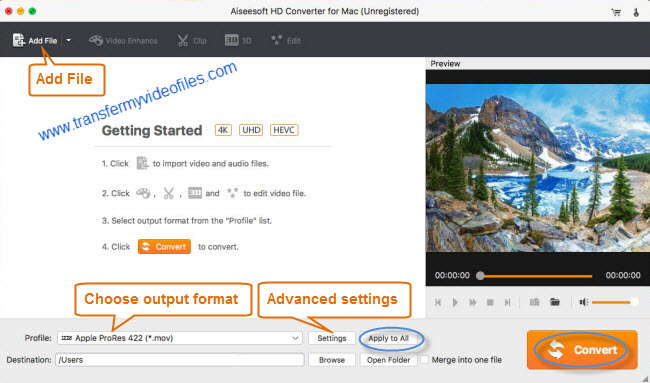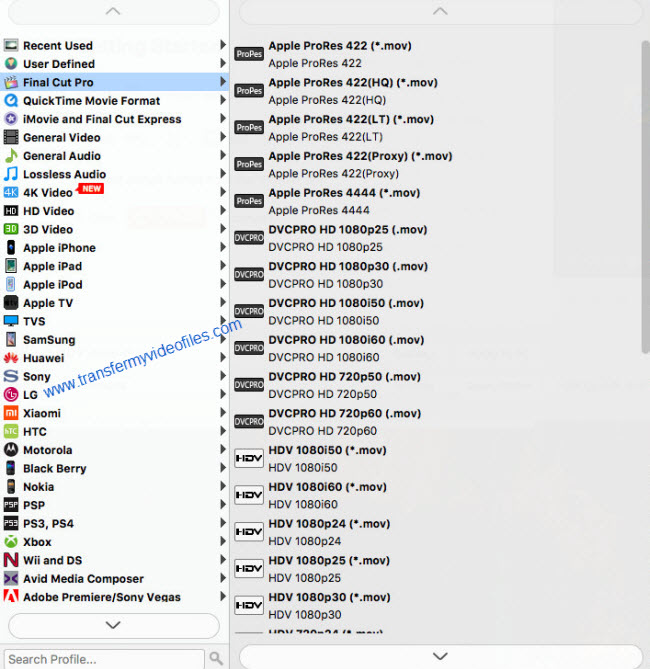If for some reason you only got a bundle of MTS or M2TS video clips without maintaining them in a complete AVCHD folder structure, and you insist on using them in FCP 7, I’m afraid that you will need third party converter software to process file conversion. In this post, we will guide you through the process of converting MTS/M2TS clips to ProRes codec for working with FCP 7 beautifully.
How to convert 1080-60p.mts files for use in Final Cut Pro 7?
“Hi, there, my client copied me tons of .mts files downloaded from a Canon C100 Mark II without preserving the entire AVCHD structure. The video specs are 1920×1080 at 60 fps. FCP 7 refused recognizing these .mts files as import without the folder structure. So I have to convert them to .mov files for use in FCP 7. My issue is that I can’t figure out a helpful app to do this keeping the 1920×1080 specs. Please help. I need to get this footage transferred one week later. I would really appreciate any help. Many thanks.”
If for some reason you need to convert mts or m2ts files for FCP 7 editing, you can give AVCHD Video Converter for Mac a shot. It can export 1920X1080 MOV files with Apple ProRes codec for use in FCP 7 with optimum performance without extra rendering process. Read on to find out a step-by-step guide talking about how to transcode MTS/M2TS files to ProRes for FCP 7 editing.
[Guide] How to convert MTS/M2TS video clips for FCP 7 editing with Apple ProRes codec?
Software requirement
HD Video Converter for Mac

Then follow these steps:
Step 1: Open up HD Video Converter for Mac as a MTS to FCP 7 Converter. When its main interface comes up, click ‘Add File’ to load your source media.

Step 2: Select output format for your editing program
To convert MTS/M2TS for FCP 7, from ‘Profile’ list, choose ‘Apple ProRes 422 (*.mov)’ as output format under Final Cut Pro’ column. Apple ProRes is the best suited editing codec for FCP 7 and its former version FCP 6 and the most recent version FCPX. When loading them into FCP (X), you needn’t wait for a long time for rendering. To create smaller files, transcode your source files to Apple ProRes 422 (LT).

Apple ProRes 422 – Higher quality than Apple ProRes 422 (LT);
Apple ProRes 422 (HQ) – Keep original video quality for editing in FCP;
Apple ProRes 422 (LT) – Get a smaller file sizes than Apple ProRes 422;
Apple ProRes 422 (Proxy) – SD levels – 480i/p and 576i/p. Used in offline workflows.
Apple ProRes 4444 – Edit and finish 4:4:4 material.
Important: If you’ve loaded a number of video clips to do batch conversion, please do remember ticking off ‘Apply to All’ option before you start.
Step 3: Custom video and audio settings (optional)
If necessary, you can click ‘Settings’ button and go to ‘Profiles Settings’ panel to modify video and audio settings like video encoder, resolution, video bit rate, frame rate, aspect ratio, audio encoder, sample rate, audio bit rate, and audio channels. 3D settings are also available.
Step 4: Begin MTS/M2TS clips to MOV Conversion on Mac
When ready, click ‘Convert’ to start format conversion. Once the conversion process is complete, you can click ‘Open Folder’ button to get the generated Apple ProRes MOV files for editing in FCP 7 or FCP 6/FCPX with optimum performance.
Tips:
If you don’t want to wait for the entire conversion process, you can tick off ‘Showdown computer when conversion completed’ and go away to do other things.
Related posts
How to open and edit Canon XA10 AVCHD mts in Final Cut Pro?
I couldn’t get Premiere Pro CS6 to recognize audio on MTS files
AVCHD and Avid – Transcode AVCHD to DNxHD for Avid import
Is lossless conversion of AVCHD to AIC for iMovie/FCE possible?
Transcode Canon G30 AVCHD MTS to DNxHD for DaVinci Resolve
